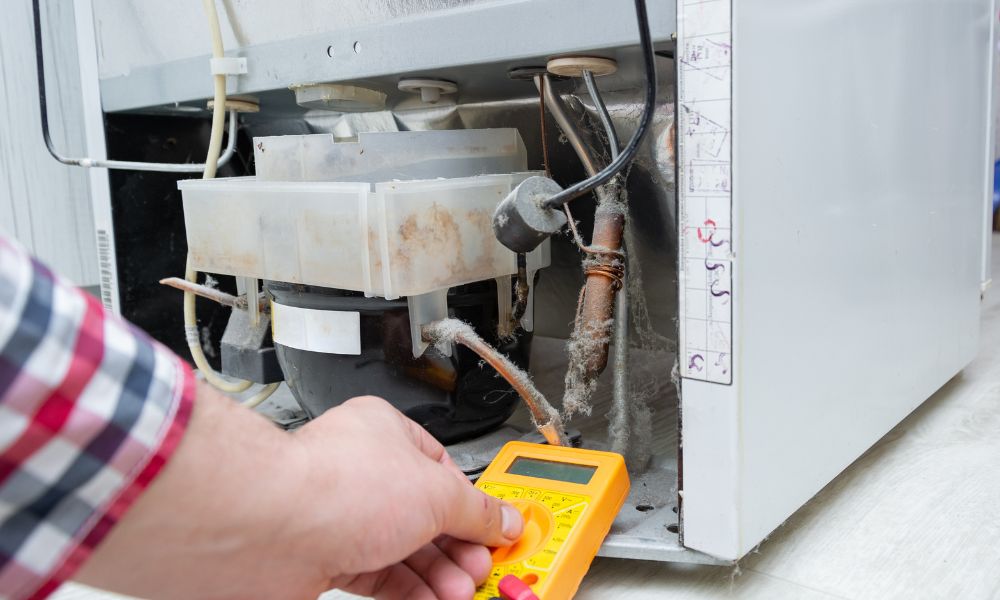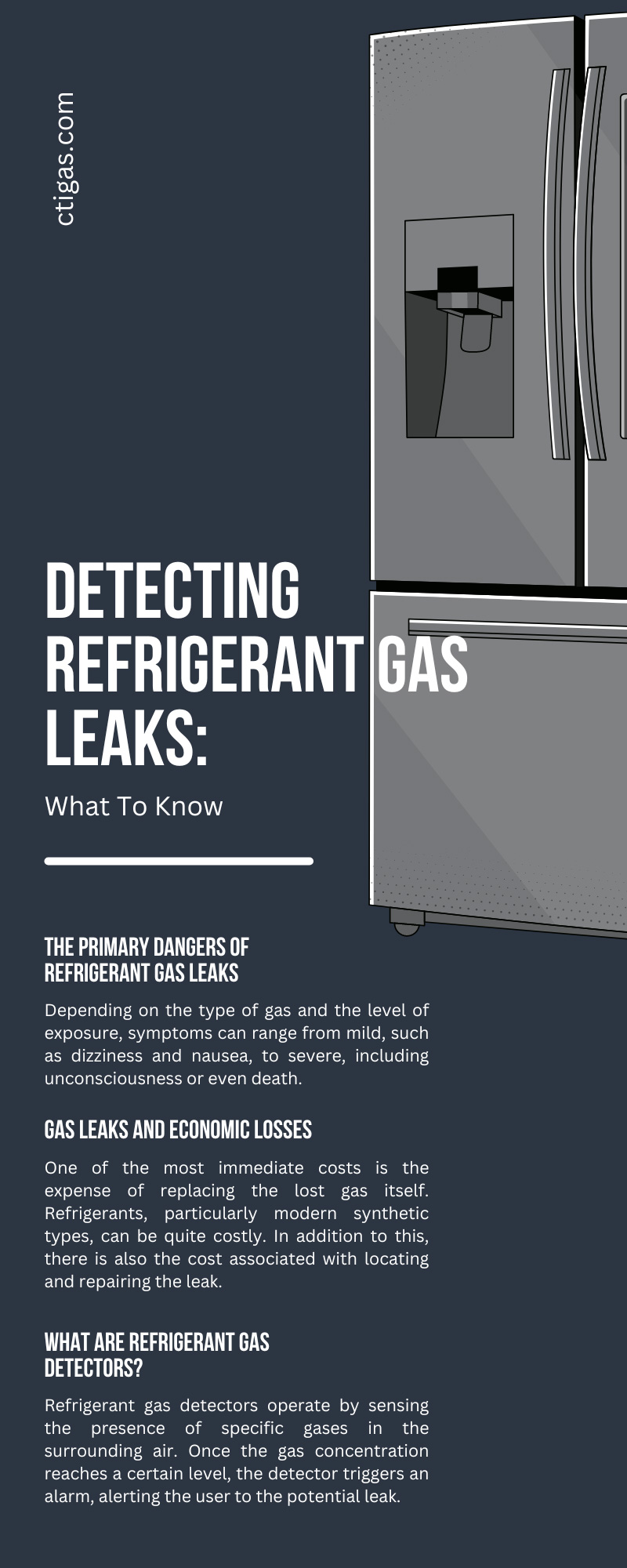
Understanding how to detect refrigerant gas leaks is crucial for industrial workers who are constantly in contact with hazardous gases. A small leak can escalate into a significant issue, affecting the health and safety of employees, the environment, and the company’s bottom line. Read on to discover everything you need to know about detecting refrigerant gas leaks.
Exploring Different Types of Refrigerant Gas Leaks
Refrigerant gases fall into three broad categories: freon-types, modern synthetics, and natural hydrocarbons. Freon-type refrigerants, also known as chlorofluorocarbons (CFCs), were common in the past, but their production has largely been phased out due to environmental concerns. Notable gases in this group include R-12 and R-22. These gases are non-flammable and non-toxic, but their release into the atmosphere contributes significantly to ozone depletion.
The industry now commonly uses modern synthetic refrigerants, such as hydrofluorocarbons (HFCs) and hydrochlorofluorocarbons (HCFCs), as replacements for CFCs. Gases such as R-134a, R-410a, and R-32 fall into this category. They are generally safe to handle, with low toxicity and flammability. However, they have a high global warming potential, which means they can contribute to climate change if released into the atmosphere.
Natural hydrocarbons, such as propane (R-290) and isobutane (R-600a), are gaining popularity as refrigerants due to their low environmental impact. They have zero ozone depletion potential and very low global warming potential. Despite these advantages, hydrocarbon refrigerants are highly flammable, which requires careful handling and storage to ensure safety. Similar to natural hydrocarbons, organic refrigerants such as NH3 and CO2 feature low environmental impact and are popular options for modern industrial operations.
The Primary Dangers of Refrigerant Gas Leaks
Refrigerant gas leaks pose significant dangers, with impacts spanning health, safety, and the environment. Understanding these hazards is paramount to mitigating risks and ensuring the well-being of all involved. From a health perspective, exposure to refrigerant gases can cause various adverse effects in people. Depending on the type of gas and the level of exposure, symptoms can range from mild, such as dizziness and nausea, to severe, including unconsciousness or even death. Prolonged exposure to these gases can lead to chronic conditions, underscoring the need for effective detection and containment.
Safety risks associated with refrigerant gas leaks are equally concerning. Certain refrigerants, particularly hydrocarbons, are highly flammable and can lead to fires or explosions if they come into contact with a heat source or spark. Even non-flammable refrigerants can displace oxygen in an enclosed space, creating an asphyxiation risk. These dangers highlight the importance of maintaining rigorous safety protocols and using appropriate detection equipment.
Lastly, refrigerant gases can wreak havoc on the environment if not properly contained. CFCs and HCFCs contribute to ozone layer depletion, while HFCs have a high global warming potential. Although more environmentally friendly, natural hydrocarbons still pose a risk when released in large quantities. Therefore, preventing and promptly addressing refrigerant gas leaks is not just a matter of personal or industrial safety but also environmental responsibility.
Gas Leaks and Economic Losses
The economic fallout from refrigerant gas leaks is substantial and multifaceted. One of the most immediate costs is the expense of replacing the lost gas itself. Refrigerants, particularly modern synthetic types, can be quite costly. In addition to this, there is also the cost associated with locating and repairing the leak. Depending on the severity and location of the leak, this process could involve significant labor hours and potentially expensive parts or equipment.
Moreover, a leaking system is less efficient and can increase energy consumption, adding to operational costs. Downtime losses while professionals repair or replace the system can also have a substantial financial impact, especially in critical refrigeration sectors, such as food retail or data centers. Furthermore, regulatory fines for non-compliance with environmental standards or safety regulations can be hefty.
Everything To Know About Refrigerant Gas Detectors
Now that you know about the types of refrigerant gases and the consequences of gas leaks, it’s time to explore the main tool for detecting potential leaks—refrigerant gas sensors! These devices play a key role in ensuring safety, protecting the environment, and preventing economic losses.
What Are Refrigerant Gas Detectors?
Refrigerant gas detectors operate by sensing the presence of specific gases in the surrounding air. Once the gas concentration reaches a certain level, the detector triggers an alarm, alerting the user to the potential leak. Some advanced models can even pinpoint the leak’s location, providing critical information for rapid response and repair.
Types of Refrigerant Gas Detectors
Several types of refrigerant gas detectors are available on the market, each with unique features and advantages. Common types include electrochemical sensors, infrared sensors, and semiconductor sensors. Electrochemical sensors react with the gas to produce an electric current, measuring the current to determine the gas concentration. Infrared sensors measure the absorption of infrared light by the gas, while semiconductor sensors change their electrical resistance when exposed to certain gases.
Gas Detector Applications
Refrigerant gas detectors are present across various industries, including HVAC, refrigeration, automotive, and manufacturing. In HVAC and refrigeration systems, they monitor for leaks to ensure system efficiency and prevent the release of harmful gases into the environment. In the automotive industry, they detect leaks in air conditioning systems. In manufacturing environments, they ensure worker safety and compliance with health and safety regulations.
Ultimately, refrigerant gas detectors are essential tools for preventing and detecting gas leaks. Understanding their functionality, knowing the different types, and recognizing their ideal applications can help you make more informed decisions based on your specific needs when finding the ideal monitor.
The importance of understanding everything there is to know about detecting refrigerant leaks is impossible to overstate. This knowledge is key to ensuring both personal safety and environmental protection. Additionally, it helps avoid the significant economic losses that can result from undetected leaks. From the health risks posed by exposure to these gases to the potential for fires and explosions, as well as the devastating impact on the environment, the dangers are manifold.
We invite you to explore our selection of sensors at CTI today. Equipped with the right tools and information, you can take proactive steps to effectively prevent and manage refrigerant gas leaks. Our range of high-quality, reliable refrigerant gas detectors can help you protect your health, safeguard your assets, and contribute to a more sustainable future. Explore our refrigerant gas sensor today and take the first step toward improved safety and efficiency.


